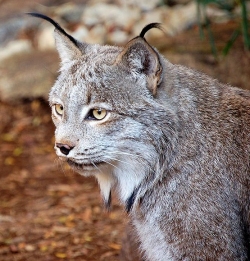Canada lynx (L. canadesis)

The Canada lynx (L. canadesis) is a close cousin of the Euroasian lynx (lynx lynx) and like the Euroasian lynx it belongs to felidae family. The Canada lynx is smaller than its European cousin weighing on average about 20 pounds (10 kg), with males being somewhat larger than females. The Canada lynx has three subspecies (L. canadensis canadensis, L. canadensis mollipilosus, and the Newfoundland Lynx - L. canadensis subsolanus).
Historically, the Canada lynx ranged from Alaska across Canada and into many of the northern U.S. states, but at present few of these beautiful cats can be found south of the Canadian border. Efforts are now being made with some success to reintroduce the species into northern American states. An ongoing project in Colorado has been a show case (see also Canada lynx epic journey) in this regard.
The Canada Lynx has dense, silvery-brown fur which becomes more reddish in summer. It has a short tail with a black tip, a characteristic furry ruff which resembles a double-pointed beard and long, furry tufts on its ears. A unique feature of the Canada lynx is its long legs and very large broad, furry feet (the fur is on top and on the pads). When the lynx walks on the snow it spreads its toes to maximize the contact surface which helps to prevent it from sinking into deep snow. On the snowy hills of Canadian north, the Canada lynx once had no predators. Unfortunately that is now changing largely because of human activities. For example, animals such as coyotes, wolves, and cougars are not comfortable in deep, soft snow. But they can access the Canadian lynx's winter habitat along trails of hard-packed snow created by snowmobiles. And of course, humans prey directly on the Canada lynx, which is trapped for its luxuriant fur.
Canada lynxes are shy creatures, by and large avoiding human contact. This elusiveness has led to the cats being referred to as the 'grey ghosts of the north'. Like most cats, Canada lynx are solitary animals and mostly hunt alone. In northern parts of its habitat, the lynx will feed almost exclusively on the snowshoe hare, although south of Canada border, where the snowshoe hare is rarer, the lynxes have a more varied diet. Their prey will include squirrels, small rodents, grouse, and hares. These cats do not have great reserves of stamina: they are fast over short distances, but lack the ability to keep up their speed for any length of time. If the lynx does not catch its prey within the first few seconds it will generally give up the chase to conserve energy.
The video below shows a Canada lynx hunting its prey.
Canada Lynxes are nocturnal, being most active during dawn and dusk. They will hunt every one or two days and consume around a pound and half of food. They often travel some distance to find food or a mate - sometimes up to 5 miles a day. Like all cats they have excellent vision and hearing. The Canada Lynx can detect prey by hearing alone from up to 250 feet away. The cats are ambush predators who remain under cover for hours, usually sheltered by a tree, waiting for prey. But as happens often in the world of predators, one's lunch is never secure. So as the lynx positions itself in ambush, a Great Horned Owl will often settle above the lynx and wait until the lynx flushes the prey from hiding. Once the prey is in the open, the owl swoops on it from above and before the lynx knows what happens his meal is gone.
In Canada, the lynx is not an endangered species and trapping and killing is legal. Detailed records of the number of lynxes caught each year are kept by the Hudson's Bay Company and Canadian government. These allow an estimate of the total population of Canada lynx and comparison of changes over an extended period - the record keeping started in 1730. Graphs showing the fluctuation in the numbers of these animals over time are interesting. The graphs show not a straight line but distinct peaks and troughs every 10 years. So every 10 years there is a sudden, very dramatic drop in the lynx population and then the numbers gradually recover, only to peak about 5 years later and then start to decline again. Further analysis has shown that this cycle is tightly connected with the number of hares available. As the number of lynxes increases, the prey becomes more sparse and a catastrophic re-adjustment takes place. In times of food shortage the adult lynxes can survive but their kittens often do not. As a result the lynx population decreases, allowing the hare population to start growing again and so the new cycle starts. Because trapping helps to level the peaks and control the number of lynxes competing for the available food supply, the effect of human predation on these cats is not harmful to the species.
Although in Canada and Alaska the Canada lynx is not endangered, this is not true for the USA. Numbers here had been steadily declining until eventually they reached just a few hundred. In March 2000, the U.S. Fish and Wildlife Service (FWS) listed the lynx as 'threatened' in the lower 48 states.

